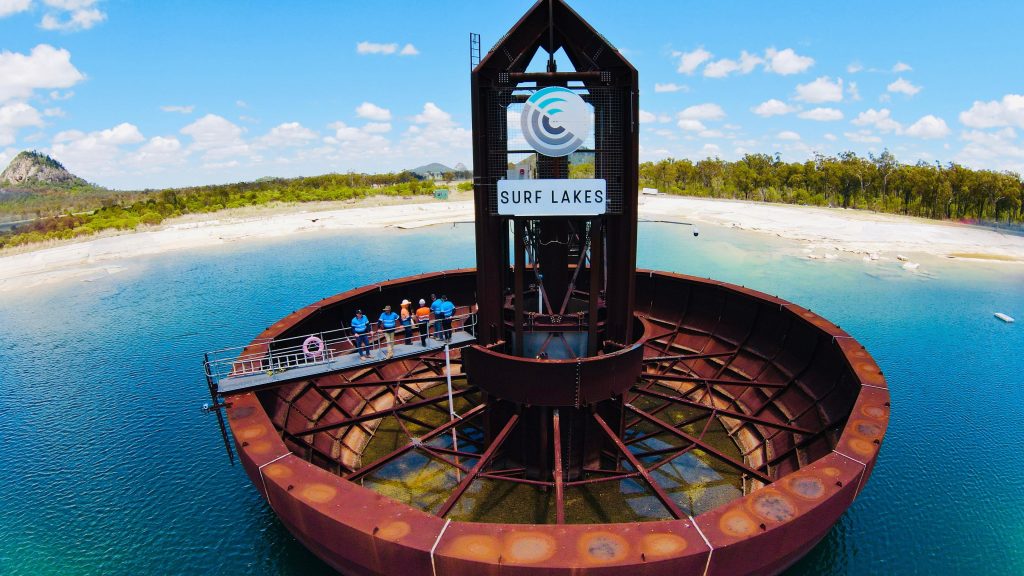A Queensland team of mechanical, electrical, civil and mining engineers has unveiled a new wave machine designed to generate ocean-like surf in a lake.
Imagine someone doing a huge dive bomb into the middle of a swimming pool. That’s the effect these engineers have manufactured.
Surf Lakes’ Central Wave Device sits in the centre of a lake, acting like a plunger to produce concentric swell that travels outwards to the shore.
The team’s latest design will be able to run on 100 per cent electricity with the aim of using renewables.
The machine can generate waves 2.4 m high, and produces up to 2000 rides an hour.
Kit Sidwell, the company’s lead R&D engineer and an avid surfer, is the co-inventor of the technology.
He helped design a combined hydraulic/pneumatic system to lift and drop the Central Wave Device.

The 1400-tonne machine lifts when compressed air is pushed through a ‘u-tube’ and drops into the lake when the air is released.
This process takes about six seconds and is repeated multiple times to create a ‘set’ of waves. After each set, the compressed air recharges for the next set.
Sidwell, a mechanical engineer, said nothing off the shelf came close to what they needed.
“In the end, I only managed to unlock [the solution] by actually going out and inventing something,” he told create.
“There’s three aspects to it really: the speed, the forces and the length of travel. Each one of those on their own is quite [a] remarkable thing.
“A machine that can do all of those three — that was where it really got hard. And then it [had] to be in the middle of a lake.”
Ripple effect
The Surf Lakes story goes that founder Aaron Trevis had the idea for a concentric swell while throwing rocks into the water with his kids.
As the former underground coal mining engineer watched the tiny waves rippling out from the splash, he wondered how large a rock would be needed to generate waves big enough to surf.
Trevis then used an Indiegogo campaign to fund a series of tests, starting in a backyard swimming pool.
As well as the plunger mechanism, the team designed the proprietary shape of the Central Wave Device’s carbon steel shell and water treatment for the lake.
They scaled the tech in 1:25, 1:10 and 1:5 scale models before building a full-scale demonstration on a 15 ha site in Yeppoon, Queensland.
Head of engineering and production Edward Szymanski FIEAust CPEng EngExec said they can vary the height of the wave by changing how far the Central Wave Device comes out of the water.
“From an operational point-of-view, [it’s] from about a 2.5 m to a 5.5 m stroke,” he explained.
Rock bottom
While the Central Wave Device generates the ripple, it’s the bathymetry — the shape of the lake floor — that creates the perfect barrel.
By manipulating the floor’s contours, Surf Lakes can create waves ranging from gentle whitewater for beginners to spinning barrels for pro surfers.
Different bathymetry in different parts of the lake means surfers can access up to eight different types of wave at a time.
“Each quadrant of the lake can have, and in our design does have, a different shape,” Szymanski said. “So you get a different level of surfability.”
Szymanski said a lot of thought went into selecting durable materials for the lake floor, to match the Central Wave Device’s expected 25-year lifespan.
“It’s 85 million L of water,” he said. “So you don’t want to be emptying the lake just to do a little bit of [maintenance] work.”
During testing, some of the liners the team trialled broke down and caused mud to leak into the lake, tarnishing the blue water.
“We looked at different synthetic liners, but at the end of the day for robustness, cost, ease of installation [and] longevity, we settled on a concrete floor,” Szymanski explained.
Future developments
For Sidwell, there’s always more that can be refined to further develop the shape of the machine and the way it interacts with the water.
Early designs were loud, and released a torrent of water vapour and compressed air from the valves.
But the latest model, designed with contractors Aspec Engineering, Tilt and Scott Carver, sees the steam and noise attenuated so they’re barely noticeable.
The team is also looking to harness energy from the waves to make the operation more sustainable without affecting the surfer.
Some sites could harness geothermal energy, see the entire lake covered with a dome structure.
“The potential is there,” Sidwell said. “We’re only just scratching the surface with what we can actually do with the machine.”